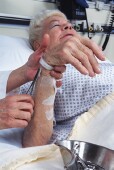No difference in primary outcome for bathing with chlorhexidine versus nonantimicrobial cloth
TUESDAY, Jan. 27, 2015 (HealthDay News) — For critically ill patients, chlorhexidine bathing does not reduce health-care-associated infections, according to a study published in the Jan. 27 issue of the Journal of the American Medical Association.
Michael J. Noto, M.D., Ph.D., from Vanderbilt University in Nashville, Tenn., and colleagues examined whether daily bathing of critically ill patients with chlorhexidine is associated with a reduction in the incidence of health care-associated infections. Data were collected from a pragmatic cluster randomized crossover study involving 9,340 patients admitted to five adult intensive care units from July 2012 through July 2013. Bathing treatments (once-daily bathing with disposable cloths impregnated with 2 percent chlorhexidine or nonantimicrobial cloths) were performed for a 10-week period, which was followed by a two-week washout period and then crossover to the alternative bathing treatment for 10 weeks.
The researchers found that there were 55 infections during the chlorhexidine bathing period and 60 during the control period. The rate of the primary outcome (composite of central line-associated bloodstream infections, catheter-associated urinary tract infections, ventilator-associated pneumonia, and Clostridium difficile infections) was 2.86 per 1,000 patient-days during the chlorhexidine bathing period and 2.9 per 1,000 patient-days during the control period (rate difference, −0.004; P = 0.95). There was no between-group difference in the rate of primary outcome after adjustment for baseline variables.
“These findings do not support daily bathing of critically ill patients with chlorhexidine,” the authors write.
One author disclosed financial ties to pharmaceutical companies; the chlorhexidine-impregnated and nonantimicrobial cloths were purchased from Sage Products.
Copyright © 2015 HealthDay. All rights reserved.








